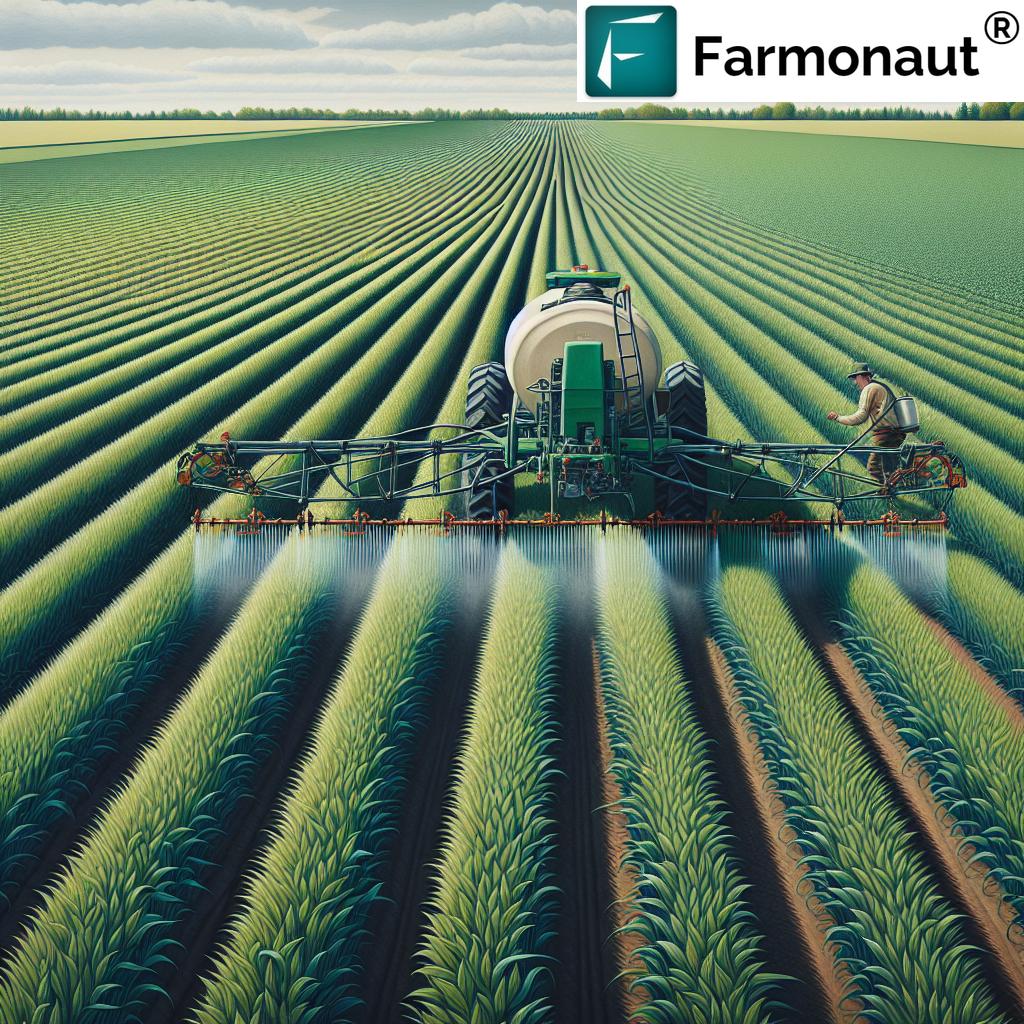Maximize Your Ontario Winter Wheat Yields: Expert Strategies for Crop Management and Monitoring with Farmonaut
“Ontario farmers planted a record acreage of winter wheat in 2023, presenting unique yield optimization opportunities.”

Welcome, Ontario farmers! As we dive into the 2023 winter wheat season, we’re faced with an exciting opportunity to maximize our yields and make the most of the record acreage planted. In this comprehensive guide, we’ll explore expert strategies for crop management and monitoring, with a focus on leveraging cutting-edge technology like Farmonaut to optimize your winter wheat production.
Understanding the Importance of Winter Wheat in Ontario Agriculture
Winter wheat has long been a staple crop in Ontario’s agricultural landscape. Its ability to withstand harsh winter conditions and provide an early harvest makes it an invaluable asset for farmers across the province. With the increasing demand for wheat globally and the potential for high yields, it’s crucial that we employ the best practices in crop management to ensure optimal results.
Key Factors Influencing Winter Wheat Yields
- Planting date and conditions
- Soil fertility and pH levels
- Pest and disease management
- Nitrogen application timing and rates
- Weather patterns throughout the growing season
- Weed control strategies
To address these factors effectively, we’ll need to implement a comprehensive approach that combines traditional farming wisdom with modern technology. This is where Farmonaut’s precision agriculture solutions come into play.
Leveraging Farmonaut for Precision Winter Wheat Farming
Farmonaut offers a suite of tools designed to help Ontario farmers make data-driven decisions throughout the winter wheat growing season. By utilizing satellite-based crop health monitoring and AI-powered advisory systems, we can gain valuable insights into our fields’ performance and take proactive measures to optimize yields.
Key features of Farmonaut for winter wheat management:
- Real-time crop health monitoring using NDVI (Normalized Difference Vegetation Index)
- Soil moisture level tracking
- Personalized farm advisory through the Jeevn AI system
- Weather forecasting for informed decision-making
- Resource management tools for efficient input application
To get started with Farmonaut’s powerful tools, simply click on the buttons below:
Winter Wheat Growth Stages and Management Practices
| Growth Stage | Timing | Management Practice | Farmonaut Technology Support |
|---|---|---|---|
| Planting | Fall (September – October) | Soil preparation, seeding, initial fertilizer application | Field mapping, soil moisture monitoring |
| Emergence | 1-2 weeks after planting | Monitor stand establishment, pest scouting | Satellite imagery for early crop health assessment |
| Tillering | Late fall – early spring | Weed control, nitrogen top-dressing | NDVI maps for targeted fertilizer application |
| Stem Elongation | Spring | Disease monitoring, herbicide application | AI-powered disease risk assessment |
| Heading | Late spring | Fungicide application, insect control | Pest pressure alerts, application timing recommendations |
| Grain Fill | Early summer | Monitor for lodging, final disease control | Yield prediction models, lodging risk assessment |
| Harvest | Mid-late summer | Determine optimal harvest timing | Harvest readiness indicators, yield maps |
Optimizing Nitrogen Application for Winter Wheat
Nitrogen management is crucial for achieving high winter wheat yields. The right amount of nitrogen applied at the correct time can significantly boost crop performance. However, over-application can lead to lodging and increased disease susceptibility.
Farmonaut’s role in nitrogen management:
- Satellite-based vegetation index maps to identify areas of nutrient deficiency
- AI-powered recommendations for nitrogen application rates based on crop health and growth stage
- Historical field performance data to inform fertilizer strategies
By utilizing Farmonaut’s precision agriculture tools, we can create targeted nitrogen application plans that maximize efficiency and minimize waste.
Effective Pest and Disease Management in Winter Wheat
“Timely fungicide applications can significantly increase winter wheat yields, with some studies showing up to 20% improvement.”
Protecting your winter wheat crop from pests and diseases is essential for maintaining high yields. Common threats in Ontario include:
- Fusarium head blight
- Powdery mildew
- Septoria leaf blotch
- Cereal leaf beetle
- Aphids
Farmonaut’s satellite-based crop monitoring can help detect early signs of pest infestation or disease outbreak. By identifying problem areas quickly, we can implement targeted control measures, reducing the need for broad-spectrum pesticide applications.
Weed Management Strategies for Ontario Winter Wheat
Effective weed control is crucial for maximizing winter wheat yields. Weeds compete with the crop for nutrients, water, and sunlight, potentially reducing yields by up to 50% if left unchecked.
Key weed management practices:
- Fall herbicide application for winter annual weeds
- Spring herbicide application for emerging broadleaf weeds
- Crop rotation to disrupt weed life cycles
- Proper seeding rates to establish competitive crop stands
Farmonaut’s satellite imagery can help identify areas of high weed pressure, allowing for targeted herbicide applications. This not only improves weed control efficacy but also reduces overall herbicide use, promoting more sustainable farming practices.

Maximizing Winter Wheat Yields Through Precision Agriculture
Precision agriculture techniques can significantly boost winter wheat yields by optimizing resource use and targeting management practices. Farmonaut’s suite of tools enables Ontario farmers to implement precision agriculture strategies effectively.
Benefits of precision agriculture for winter wheat:
- Improved input efficiency (fertilizers, pesticides, water)
- Reduced environmental impact
- Enhanced crop quality and consistency
- Better farm profitability through optimized resource allocation
By leveraging Farmonaut’s satellite-based crop monitoring and AI-powered analytics, we can make data-driven decisions that lead to higher yields and more sustainable farming practices.
Weather Considerations for Ontario Winter Wheat Production
Weather plays a crucial role in winter wheat development and yield potential. Ontario’s climate can present challenges, from harsh winters to potentially dry springs. Understanding and preparing for these weather patterns is essential for successful crop management.
Farmonaut’s weather forecasting capabilities:
- Accurate short-term and long-term weather predictions
- Alerts for extreme weather events
- Integration of weather data with crop health monitoring for comprehensive field assessments
By utilizing Farmonaut’s weather forecasting tools, we can make informed decisions about planting dates, input applications, and harvest timing, all of which contribute to maximizing yields.
Sustainable Winter Wheat Farming Practices
As we strive to maximize yields, it’s equally important to consider the long-term sustainability of our farming practices. Implementing sustainable methods not only benefits the environment but can also lead to improved soil health and consistent yields over time.
Sustainable practices for winter wheat production:
- Conservation tillage to reduce soil erosion
- Cover cropping to improve soil structure and nutrient content
- Integrated pest management to minimize chemical inputs
- Precision agriculture for targeted resource application
Farmonaut’s technology supports these sustainable practices by providing detailed field insights that allow for more precise and efficient farming operations.
Planning for Success: Winter Wheat Acreage Management
With record acreage planted in Ontario this year, effective planning and management of winter wheat fields are more important than ever. Farmonaut’s field mapping and monitoring tools can help farmers make the most of their planted acres.
Strategies for managing large winter wheat acreages:
- Implement zone management based on soil types and field history
- Use satellite imagery to prioritize field operations and scouting efforts
- Leverage historical yield data to inform current season decisions
- Utilize Farmonaut’s fleet management tools for efficient equipment deployment
By effectively managing larger acreages, we can ensure that each field receives the attention it needs to produce optimal yields.
Harnessing Farmonaut’s Technology for Winter Wheat Success
Farmonaut’s suite of precision agriculture tools offers Ontario winter wheat farmers a comprehensive solution for crop management and monitoring. By integrating satellite imagery, AI-powered analytics, and real-time weather data, Farmonaut empowers farmers to make informed decisions throughout the growing season.
Key benefits of using Farmonaut for winter wheat production:
- Early detection of crop health issues
- Optimized input application through precision agriculture
- Improved yield forecasting and harvest planning
- Data-driven decision-making for all aspects of crop management
To explore how Farmonaut can help maximize your winter wheat yields, visit our website or download our mobile app:
Farmonaut Web App
Farmonaut Android App
Farmonaut iOS App
For developers interested in integrating Farmonaut’s satellite and weather data into their own systems, check out our API:
Farmonaut API
API Developer Docs
Conclusion: Embracing Technology for Higher Winter Wheat Yields
As we look to maximize our winter wheat yields in Ontario, it’s clear that combining traditional farming knowledge with cutting-edge technology is the path to success. By leveraging Farmonaut’s precision agriculture tools, we can optimize every aspect of our crop management, from planting to harvest.
Remember, successful winter wheat production requires attention to detail, timely interventions, and data-driven decision-making. With the right strategies and tools at our disposal, we can make the most of this year’s record acreage and achieve outstanding yields.
Let’s embrace the power of satellite-based crop monitoring, AI-driven insights, and precision agriculture to take our winter wheat farming to new heights. Together, we can ensure a bountiful harvest and a sustainable future for Ontario’s agriculture.
FAQ Section
Q: How can Farmonaut help me improve my winter wheat yields?
A: Farmonaut provides real-time satellite-based crop health monitoring, AI-powered advisory services, and precision agriculture tools that enable you to make data-driven decisions about fertilizer application, pest control, and resource management, all of which contribute to optimizing yields.
Q: Is Farmonaut suitable for small-scale farmers?
A: Yes, Farmonaut is designed to be accessible and affordable for farmers of all scales, from small family farms to large agricultural operations.
Q: How accurate is Farmonaut’s satellite imagery for crop monitoring?
A: Farmonaut uses high-resolution satellite imagery and advanced algorithms to provide accurate crop health assessments. The system is continuously improved and calibrated to ensure reliability.
Q: Can Farmonaut help me comply with sustainable farming practices?
A: Absolutely. Farmonaut’s precision agriculture tools enable more efficient use of resources, reducing environmental impact while promoting sustainable farming practices.
Q: How often is the satellite data updated on Farmonaut?
A: The frequency of updates depends on the subscription plan, but typically ranges from daily to weekly updates, ensuring you have access to timely information throughout the growing season.






